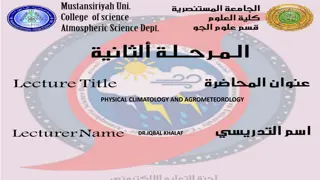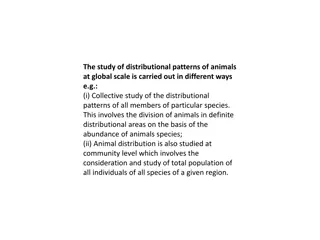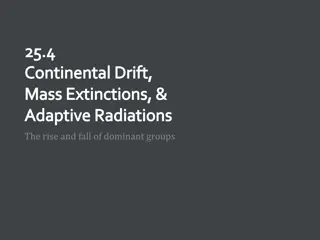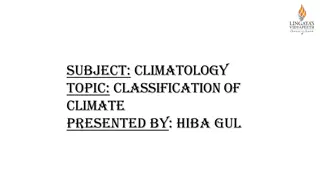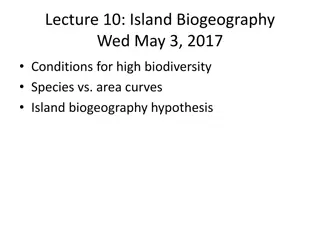Understanding Global Distribution Patterns of Animals in Climatology and Biogeography
Studying the distribution patterns of animals globally involves complex factors such as environmental conditions, zonal patterns, and latitudinal influences. Animal distribution is influenced by factors like sunlight availability, vegetation diversity, and evolutionary origins. Different animal zones form due to dispersal, migration, and colonization, contributing to the diversity and abundance of species in various regions.
Download Presentation

Please find below an Image/Link to download the presentation.
The content on the website is provided AS IS for your information and personal use only. It may not be sold, licensed, or shared on other websites without obtaining consent from the author. Download presentation by click this link. If you encounter any issues during the download, it is possible that the publisher has removed the file from their server.
E N D
Presentation Transcript
B.A 2NDSEMESTER PAPER-2026 CLIMATOLOGY AND BIOGEOGRAPHY
WORLD DISTRIBUTION OF MAJOR ANIMALS The study of distributional patterns of animals at the global scale is carried out in different ways e.g.: A collective study of the distributional patterns of all members of particular species. This involves the division of animals into definite distributional areas on the basis of the abundance of animal species. Animal distribution is also studied at the community level which involves the consideration and study of the total population of all individuals of all species of a given region. It may be pointed out that the distributional patterns of animals at global or regional levels are more complex than the distribution of vegetation because animals are very much mobile. Thus no animal species is universally distributed because several factors distort the uniformity of distributional patterns of animals.
Distribution of Land Animals The following facts must be taken into account while studying the world distributional patterns of animals: Physical environmental conditions determine the number, abundance, and diversity of animals. Maximum diversity is noticed among the vertebrate animals of the land and freshwater habitats of the tropical regions. There is a zonal pattern in the world distribution of animals. This zonal pattern of the animal distribution is in two forms viz.: (i) Horizontal zones, and (ii) Vertical zones.
Latitudes have maximum control on the horizontal zonal patterns of animal distribution because sunlight decreases from the equator towards the poles, which means there is a corresponding decrease in vegetation and its diversity towards increasing latitudes, and hence species diversity also decreases from the equator towards the poles. It may be further pointed out that the origin and evolution of animals first took place in the tropical or the equatorial regions from where animals were dispersed to other areas. Thus the development of animal zones in the higher latitudes took place because of the dispersal and migration of animals from the animal zones of the tropical regions.
Thus the horizontal animal zones of the higher latitudes are the result of the dispersal and migration of animals and various phases of speculation. For example, the development of the temperate animal zone took place due to the subtraction of animals during their migration from the tropical zone. The animals have radiated in all directions from the centers of their origin. In other words, the animals have dispersed and migrated in all directions through various routes from the centers of their origin. Consequently, the distributional patterns of the world fauna are found in concentric zones. The diversity of animals of any region is the result of several phases of their dispersal and colonization. The concentration of animals could be possible only in mammals whereas the distribution of other species of animals is more widespread and is not specific.
The distributional patterns of all the animal species are not uniform because the distribution of the same animal species is continuous while that of other species is discontinuous or disjunct. For example, the distribution of moose (a type of deer) is found in the continuous zonal pattern in the taiga regions of North America and Eurasia whereas the distribution of Azure-winged maggie, weather fish, and bitterling is discontinuous as their two continuous distribution zones in middle and western Europe and in south-east Asia are separated by an extensive zone devoid of these animals. Oceanic islands are characterized by special types of animals because there has been minimum migration and dispersal of plants and animals to the islands because of great oceanic barriers.
Hawaii Island, which was never connected with any landmass in the geological history of the earth, lacks in reptiles, amphibians, freshwater fishes, and mammals (except one species of bats). A.R. Wallace attempted the classification of world animals into faunal regions in 1876. Since then a number of attempts have been made to divide the world animals into faunal regions by several scientists e.g., P.J. Darlington (1957), S.C. Kendleigh (1961), W. George (1962), De Latin (1967), W.T. Neil, and M.D.F. Udavardy (1969), De Laubenfels (1970), J. lilies (1974), etc. but still the division of world animals into faunal regions as presented by A.R. Wallace is the most convincing and acceptable among all the subsequent divisions.
Normally, the world is divided into the following 6 major faunal regions: Palaearctic region Nearctic Region Oriental Region Ethiopian Region Australian Region Neotropical Region 1. Palaearctic region Palaearctic region includes Europe and middle and north Asia which represent 28 chordate families.
The important animals of this great faunal region are Russian desmans, dormice of Eurasia, Mediterranean mole rats, saiga and chiru antelope (a type of deer), acentors, crocodiles, lizards etc. Reptiles are found in lesser number. This faunal region is further divided into 5 sub-regions on the basis of vegetation e.g.: i. Tundra region represents caribou, lemming, muskox, arctic hare, arctic fox, wolf, polar bear, etc. ii. Temperate coniferous forest region moose, mule, deer, lynx, etc. are the important animals of this region, iii. Temperate grassland region represents saiga, wild ass, horse, camel, jerboa, hamster, jackal, etc.,
iv. Deciduous forest region represents racoons, oppossum, red fox, black bear as important animals, and v. Desert region the important animals of this region are lizards, snakes, hamster, hedgehog, rats, jerboa, cottontail, etc. The Palaearctic faunal region includes 136 families of vertebrate animals, 100 genera of mammals, and 174 genera of birds. Besides, 3 unique families of vertebrate animals, 35 and 57 unique genera of mammals and birds respectively are also found in the Palaearctic faunal region. 2. Nearctic Region: Nearctic region consists of the geographical territories of North America and Greenland. It is significant to point out that there is much similarity between the Palaearctic and Nearctic faunal regions.
Both the regions were connected through the Bering Land Bridge during Tertiary Epoch and Pleistocene periods. This land bridge enabled free exchange and migration of animals between these two regions which resulted in much mixture of animal species and therefore increase in species diversity. For example, American and European bisons reproduce after having sexual intercourse between them. Both regions have salmons and trouts. On the basis of such biological similarities between Palaearctic and Nearctic regions, some scientists have grouped these two regions into one single region as Holarctic region. It may be pointed out that in the beginning, horses, pigs, goats, and sheep were not present in the Nearctic region but later on these animals migrated to North America from N.E. Asia through the land- bridge of Bering Strait.
Nearctic faunal region is also divided like Palaearctic region into 5 sub- faunal regions on the basis of vegetation: i. Tundra region is characterized by the dominance of caribou, musk ox, lemming, arctic wolf, arctic fox, polar bear, etc. It may be pointed out that the genera of the animals of Palaearctic and Nearctic faunal regions are the same but their species vary. ii. Temperate coniferous forest region includes moose, mule, deer, wolverine, lynx, etc. iii. Temperate grassland region is characterized by bison, pronghorn, jackrabbit, prairie dog, gopher, fox, coynote, etc. iv. Deciduous forest region includes racoons, oppossum, red fox, black bear, etc. The genera of animals of deciduous forest regions of the Palaearctic and Nearctic faunal regions are almost the same but their species vary. v. Desert region is characterized by lizards, snakes, kangaroo, jerboa, hamster, hedgehog, cottontail, etc.
3. Oriental Region: The oriental region includes the geographical areas of mainly south and south-east Asia. The Himalayas, Tibetan plateau, and Chinese mountainous regions form transitional zones between Palaearctic and oriental faunal regions. Similarly, East Indies form transitional zone between Oriental and Australian faunal regions. The whole of this faunal region falls under tropical regions and hence this faunal region is associated with the Ethiopian faunal region. This faunal region represents 164 families of all vertebrates, 118 genera of mammals, and 340 genera of birds out of which there are 12 unique families of vertebrates, 55 unique genera of mammals, and 165 unique genera of birds.
This faunal region is characterized by the dominance of Indian elephants, rhinos, several species of deers, antelopes, pheasants, tigers, lizards, snakes, gibbons, monkeys, sun bears, porcupine, etc. Tree shrews, gibbons, orangutans, and tapirs are the typical animals of the Oriental faunal region. 4. Ethiopian Region The Ethiopian region incorporates substantial areas of the whole of Africa south of Sahara and far off southwestern Arabia which is separated from the African region by the Red Sea. This faunal region also falls under tropical climatic regions. Unlike other faunal regions, this region is characterized by minimum diversity of animals though there is the complete absence of moles, beavers, bears, and camels in this region.
This faunal region is further divided into 3 sub-regions: i. Desert region is characterized by the dominance of springbok, porcupine, jerboa, rock hyrax, etc. ii. Savanna region represents zebra, eland, gemsbok, hartebeest, gnu, giraffe, elephant, ostrich, lion, cheetah, etc. iii. Tropical forest region includes important animals like okapi, gorilla, chimpanzee, monkey, forest elephant, etc. There is a similarity in a few animals of the Oriental and Ethiopian faunal regions like elephants, lions, cheetah, etc. Hippopotamus, aardvark, ostrich and rodents, and a few species of insectivorous animals are exclusively found in the Ethiopian faunal region.
5. Australian Region: Australian region includes Australia, New Zealand, and islands between S.E. Asia and Australia (such as New Guinea, Soloman, Samoa, etc.). Some scientists do not include New Zealand in the Australian faunal region. There is a difference of opinions among the scientists about the linkage of this region with the oriental faunal region. This region is dominated by placental animals. Marsupials (characterized by pouch attached to the outer part of their abdomen) are the typical animals of the Australian faunal region. These animals carry their off-springs in their pouch which has feeding mechanisms.
This faunal region is further divided into 3 subregions: i. Desert region is characterized by marsupial, mole, jerboa, parakeet, lizard, etc. ii. Savanna region is represented by emu, red kangaroo, bandicoot, wombat, cockatoo, parrot, etc. iii. Tropical forest region is dominated by the tree and musk kangaroos, wallaby, koala, oppossum, cassowary, etc. 6. Neotropical Region: The neotropical region includes the whole of South America which is characterized by tropical environments. This region represents the largest number of exclusive mammals (which are not found elsewhere).
About 32 families of marsupials (which are quite different from the Australian marsupials), and several typical and special families and genera of monkeys, birds, and rodents are exclusively found only in this faunal region. This faunal region is further divided into 3 sub-regions i. Temperate grassland region is dominated by guanaco, rhea, viscacha, cavy, fox, shunt, etc. ii. Desert region is characterized by guanaco, rehea, armadilo, vulture, etc. iii. Tropical forest region is represented by monkeys, kinkajou, pygmy ant eater, sloth, tree snakes, parrot, hummingbirds, etc.
Some scientists have assigned the status of minor faunal region to those islands which have been connected with the mainland (though this concept of isolation of some islands from the mainland throughout the geological history of the earth is still debatable). Such islands include Hawaii Island, Greater Antilles, Madagascar, and New Zealand. The solenodons and hutia family of rodents in the Greater Antilles; tenrecs, lemurs, aye-aye, Malagasy mongooses and fossa, Malagasy rats and vanga shrikes in Madagascar and Kiwis, tustara, New Zealand frogs, etc. in New Zealand are some of the important animals of such so-called isolated islands.
WORLD DISTRIBUTION OF LAND ANIMALS AND MAJOR FAUNAL REGIONS OF THE WORLD Source:Environmental Geography,Savindra Singh






